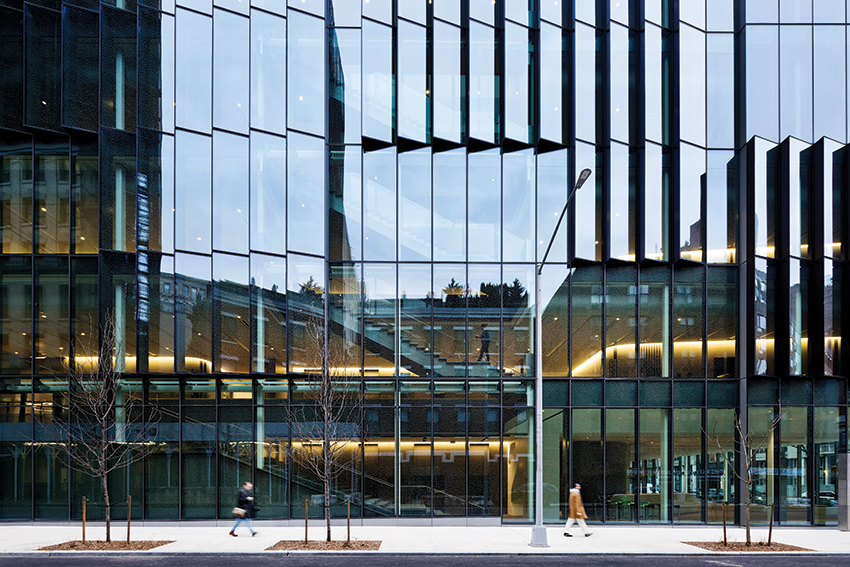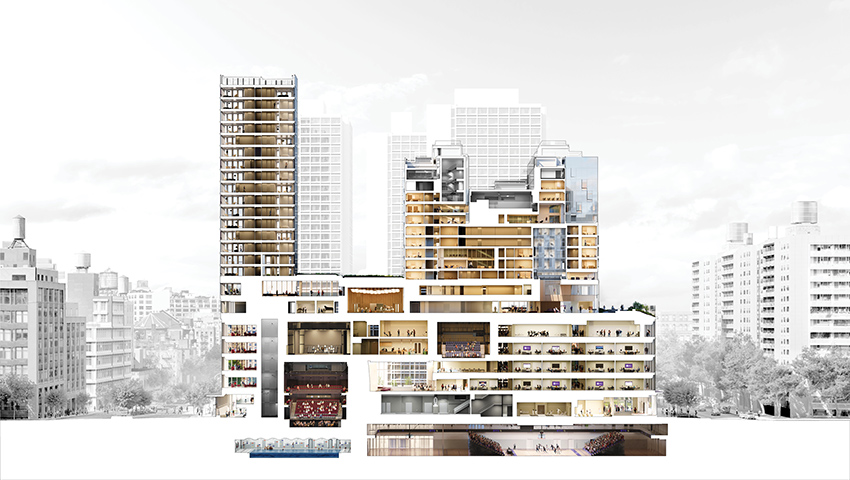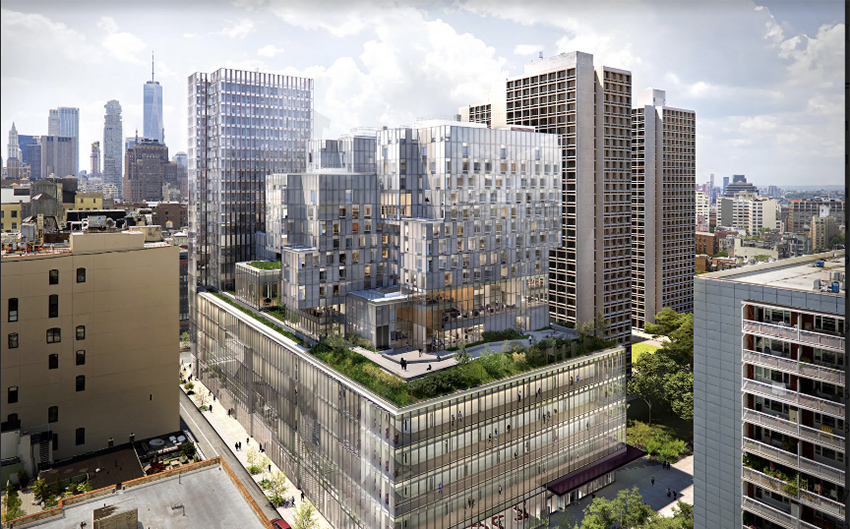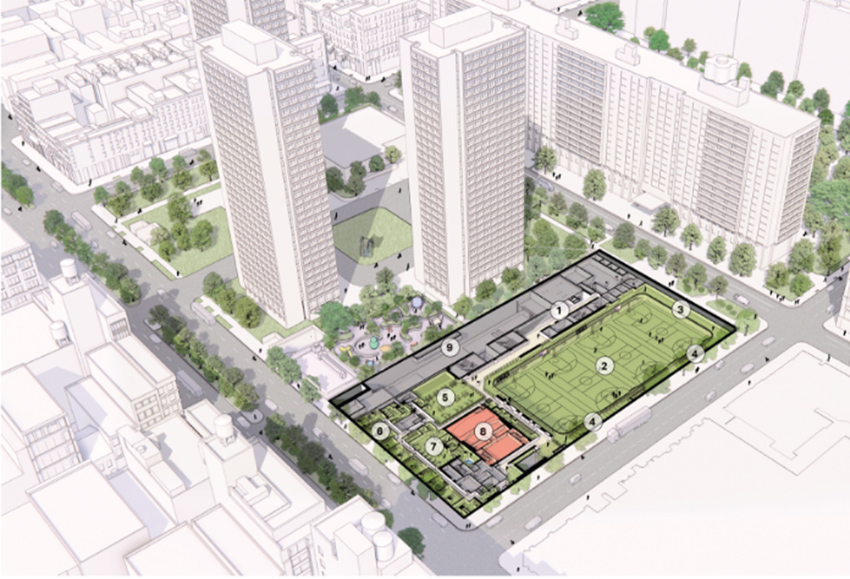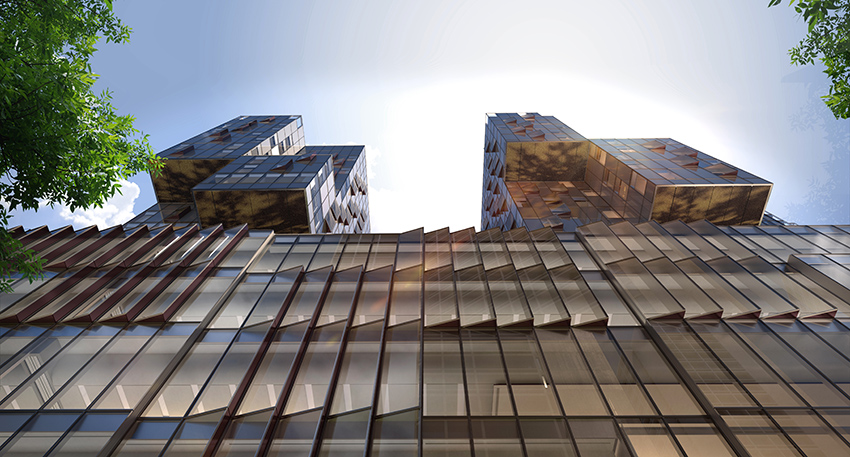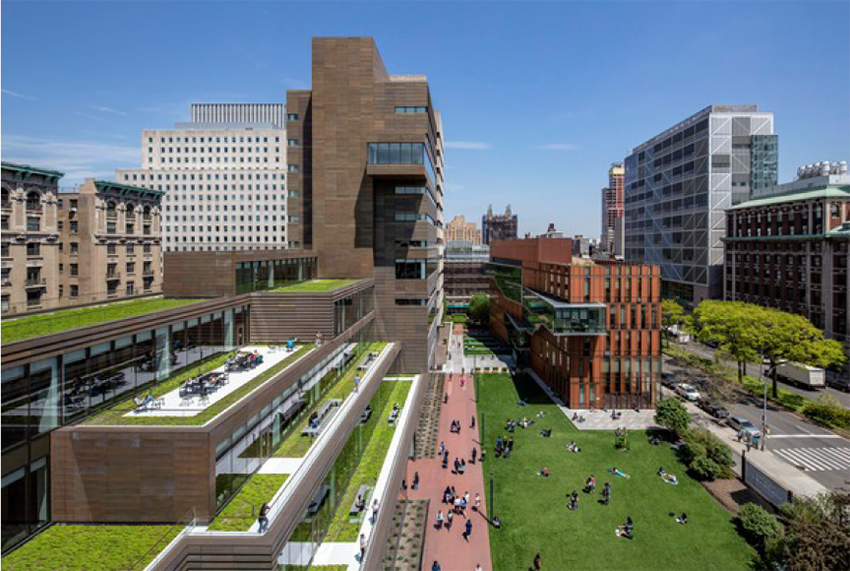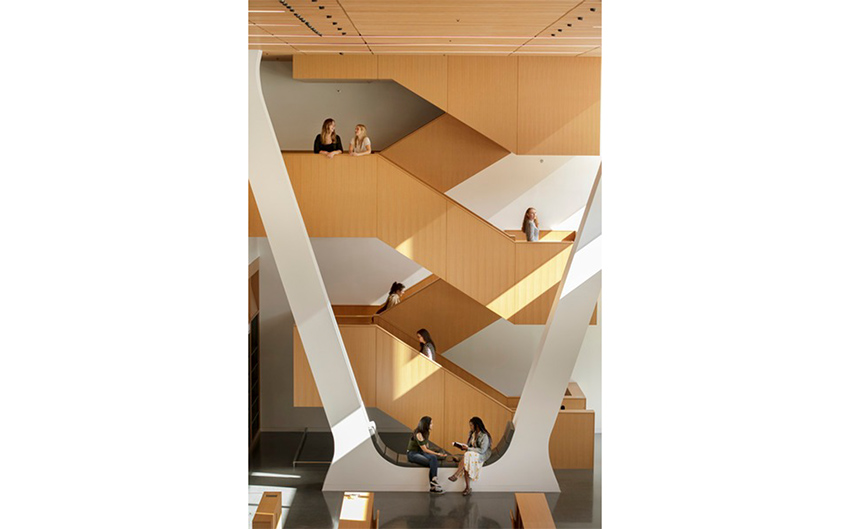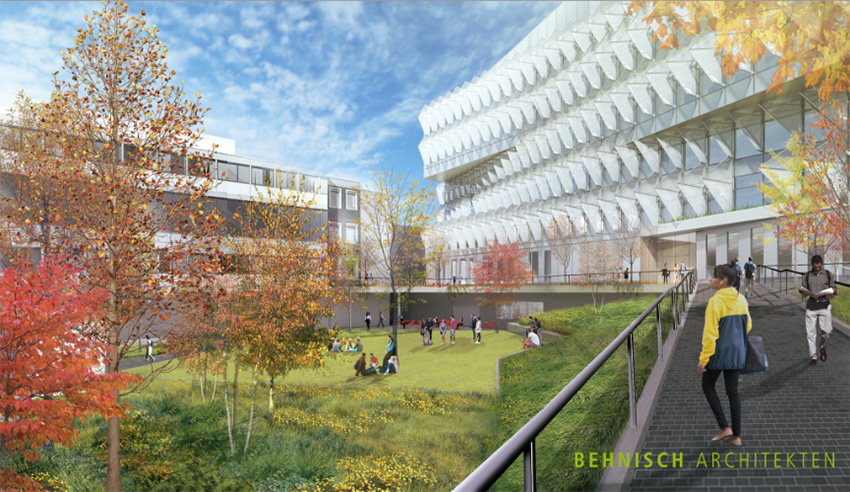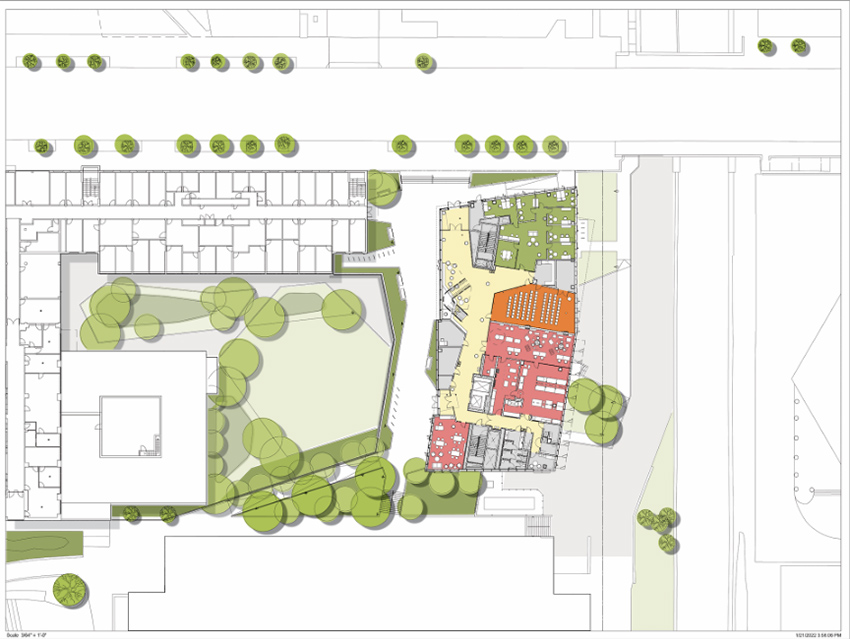Columbia Business School's Kravis and Geffen Halls: Structured to Maximize Mixing
Columbia's expansion into West Harlem, a multi-decade initiative announced in 2003 and master-planned in 2007 by Renzo Piano Building Workshop and SOM, aims to relieve the institution's geographical squeeze, adding space for teaching, research, and community service, and also to change the institution's identity. A university whose institutional memory remains marked by the unrest of 1968, after neighbors perceived a planned gym as an exclusionary insult and joined rebel students in antiwar, anti-institutional protest, now treats that third goal, service, as essential. Its new Manhattanville campus, now comprising five new buildings with the addition of the Business School's Kravis and Geffen Halls designed by Diller Scofidio + Renfro (DSR) and FXCollaborative, strives for public access and spatial porosity.
Columbia's Morningside campus a few blocks south, with McKim, Mead & White buildings gated off from the surrounding streets, is paradigmatic of the traditional academic conclave. Manhattanville pursues the opposite urban strategy, emphasizing what DSR's project director Miles Nelligan calls “hyper-transparency” and actively commingling populations; campus features aimed at lowering the town-gown barrier include public access to Columbia facilities, a neighborhood K-8 school, and ground-floor retail or clinics in all buildings. Applying a similar principle internally, Kravis (see Image 8) follows an anti-hierarchical parti based on alternating floors for classrooms and faculty offices, using prominent sculptural “network stairs” to maximize serendipitous student-faculty contacts (as its partner building Geffen does with students and administrators; see Image 9), shuffling programs like a deck of cards. Glazing differentiates the two types of floors: translucent white fritted glass for faculty floors, clear glass for student floors, with the overhanging cantilevers of the former providing shade for the latter.
The Business School needed 492,000 total square feet, enough space for 19 floors, nearly doubling its previous quarters. No single Manhattanville site would have provided that much area; a tower of that scale would have been oversized for the neighborhood, along with sending most vertical circulation to elevators and reducing the desired mixing of populations. Instead, the school occupies two sites flanking a 40,000-square-foot public park (designed by James Corner Field Operations and designated The Square, though its lawn is circular; “we have pointed that out,” Nelligan says). Kravis's 11 stories above grade (292,000 square feet) and Geffen's eight (190,000 square feet) provide equivalent usable space in an arrangement that Nelligan compares to “siblings with the same DNA, but they differ.” A network of student spaces “starts at the urban layer with two large gestures,” a 274-seat auditorium in Geffen (Cooperman Commons) and Kravis's 200-seat Samberg Commons, facing each other across the Square. “When we give tours,” he continues, “we can give a lecture in a space in our building while the backdrop is also our building, so it creates a bit of energy between the two.”
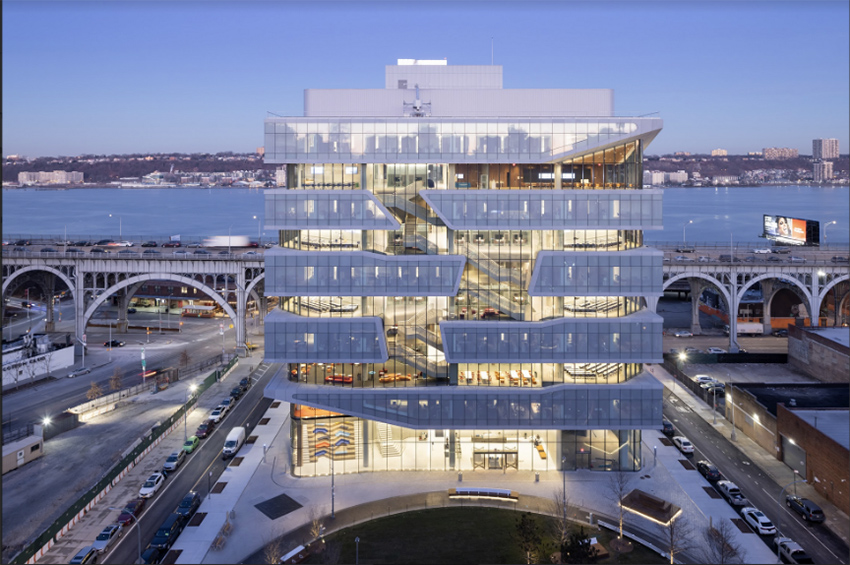
Photo courtesy of Iwan Baan; Diller Scofidio + Renfro
Image 8: Kravis Hall, Columbia Business School, east elevation.

Photo courtesy of Iwan Baan; Diller Scofidio + Renfro
Image 9: Geffen Hall, Columbia Business School, west elevation.
“The normal way of doing a design like this is, you would put the large span, the biggest spaces, on the bottom of the building, for your elevator and your structural efficiency, and you put the faculty on top, with the smaller offices,” Nelligan says. “But what we wanted to do with these two buildings was, first of all, we wanted two hot buildings, so we weren't going to put all the classrooms in one building and all the offices in another. The second thing is we wanted both constituencies, the faculty and administration and the students, to be able to own the whole building from the bottom to the top, so that every person can go in any space in the building... it's not like the ivory-tower model, where it's the faculty above and you go there by appointment. These two consistencies are always rubbing past each other, always in some serendipitous encounter.... In the Kravis building, we begin to link those two floors together by the staircase system, so they begin to pull through the other floors, so that each program is always passing through another program to get to its next place.”
Kravis exposes its network stairs to the exterior through three large parallelogram-shaped voids in the bands of translucent glass on faculty floors, a signature feature that maximizes daylight inside and visually defines the east facade; from the western view, across the Hudson or from the Riverside Drive viaduct, solid parallelograms connect the cladding and echo the east facade's voids. Another stair on the west side, Nelligan adds, provides “what we call a valve space, which is a communal teaching space between the students and the faculty” wherever it alights on a student floor. Each corner of Kravis is anchored by a 75-person classroom, “the main building module of the teaching floors,” with smaller classrooms scaling down to six-person study/breakout rooms. All faculty offices are the same size, and there are no corner offices, just corner lounges and conference spaces. “The only thing that varies in this building is the view and the orientation,” Nelligan says. “Everything else is identical…. The cantilevered corner classrooms respond to the size of the program behind, pushing the floor out from the envelope,” with 74-person and 150-person classrooms extending the cantilevering. The smaller Geffen contrasts with Kravis in its exterior, with a facade of glass fiber-reinforced concrete (GFRC) and fritted glass in a transparent-to-opaque gradient pattern between teaching and administrative areas, and in its arrangement of classrooms.
“When we talk about why is steel appropriate to design,” Nelligan notes, “we go back to the immediate stacking idea of alternating the populations, which requires a structural system that can respond at every floor in a different way,” supporting the staircases and the various-sized classroom modules in “a structural system that runs up and down the whole building. So in trying to have the teaching spaces as unencumbered with structure as possible, we ended up with... a 45-by-45-foot grid” in student floors. Faculty floors have a more cellular plan, with cantilevering on all four sides, and a “skip-truss” system (see Image 11) helps with the cantilevered corners, “getting those trusses to skip over the inhabited areas, so we're not having to deal with diagonals in open space.” The system uses A992 and A572 steel, both grade 50, reports Alex Leung of FXCollaborative. Total steel tonnage in the two buildings is around 4,000T, split approximately 50/50.
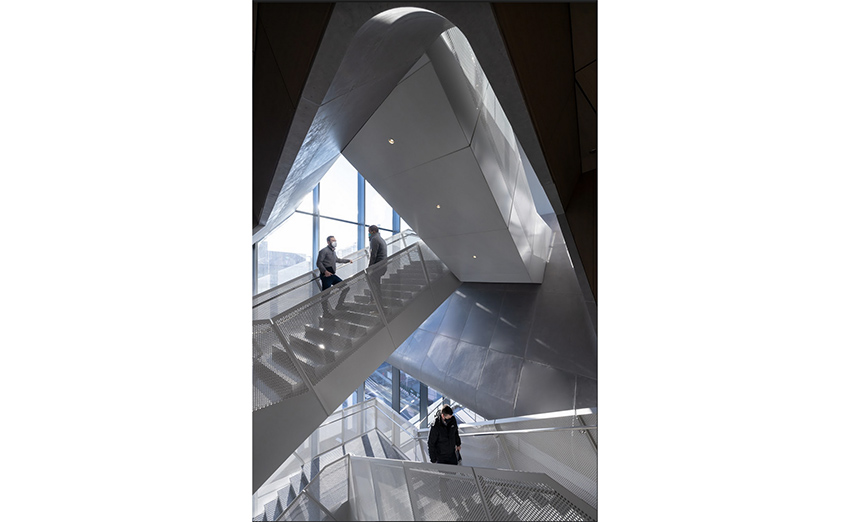
Photo courtesy of Iwan Baan; Diller Scofidio + Renfro
Image 10: Network staircase, Kravis Hall.
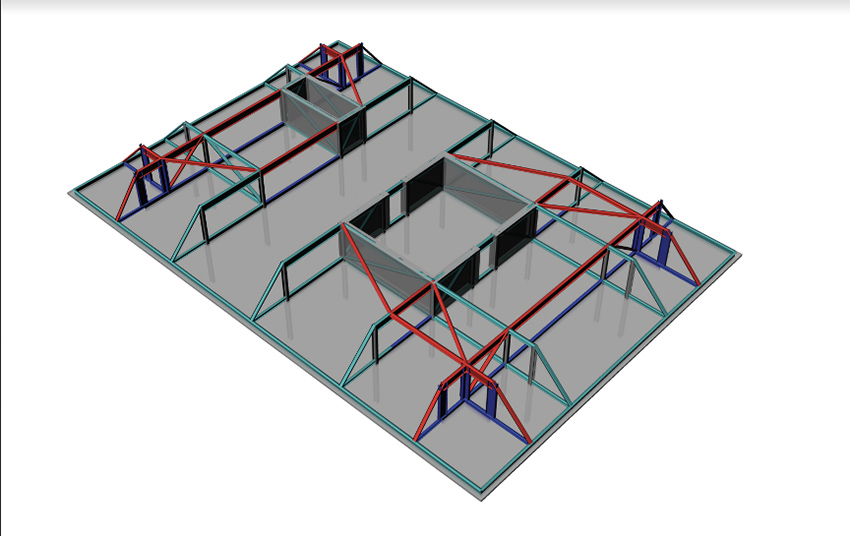
Photo courtesy of Arup
Image 11: Skip-truss system, Kravis Hall.
Columbia requires Manhattanville buildings to attain LEED Silver sustainability metrics (these two reach the Gold level) and to exceed local code requirements for flood protection by raising ground-floor entrances above the flood-plain levels observed during the Sandy event. Leung points out that the buildings address their operational carbon footprint with a chilled-beam cooling system, low-VOC content, and fritted glazing, among other strategies, and embodied carbon with recycled materials and FSC-certified woods. “The chilled beam really helped us to reduce the height of each floor, instead of having a heavy duct air-delivery system,” he says.
Reconciling M.B.A. training with a modern university's environmental mission (especially that of Columbia, where its Earth Institute and its new transdisciplinary Climate School, established in 2020, make substantial institutional commitments to the planetary emergency response) may be, to some observers, as improbable as squaring a circle. Leaders of the Business School have gone on record supporting a new philosophy of business education, more interdisciplinary and reliant on co-teaching (conceivably with faculty from the humanities as well as engineering and other fields closer to corporate endeavors), and less focused on financial gain as an end in itself than some long-dominant economic theories have advocated (Russell).
Whether such an approach to philosophy, design, or pedagogy can catalyze significant changes in the firms that will hire most of the Business School's graduates, let alone in the economic systems within which they operate, is a debate for a different setting. Still, facilities that build openness and versions of equality explicitly into their physical form, ensuring that no one in this rarefied atmosphere can become too insular and that everyone comes into occasional contact with everyone, appears consistent with a vision of business education as a plausible engine of progress.

